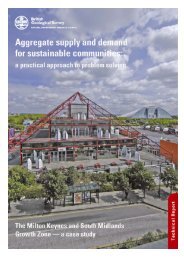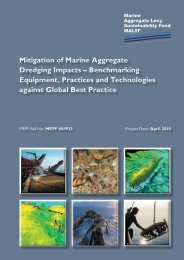creating environmental improvements through biodiversity
creating environmental improvements through biodiversity
creating environmental improvements through biodiversity
You also want an ePaper? Increase the reach of your titles
YUMPU automatically turns print PDFs into web optimized ePapers that Google loves.
Sustainable Aggregates Creating Environmental Improvements <strong>through</strong> Biodiversity<br />
the Wildlife Trusts (Ecoscope 2000)’<br />
Statement that vegetation establishment will depend on soil resources, and these are limited in most hard<br />
rock quarries – soil or soil-forming materials can be imported, but in recent quarries the original soils are<br />
often stored<br />
Guidance on setting aims and objectives for quarry reclamations, including for scarce species and BAP target<br />
habitat<br />
Discussion of <strong>environmental</strong> site designations, including their benefits in providing a guide to locally<br />
appropriate reclamation aims<br />
Statement that local landscape setting and <strong>biodiversity</strong> should be a primary consideration in reclamation aims<br />
and objectives<br />
Examples of possible ecological reclamation targets for hard rock quarries<br />
Statement that areas proposed for habitat creation may require detailed survey to identify whether any<br />
notable species are already present<br />
Pointers to guidance on Environmental Assessment<br />
Discussion of Environmental Impact Assessment and survey requirements including ecological assessment<br />
Tables of typical detailed site investigations, including vegetation/habitat surveys, faunal surveys, landscape and<br />
visual impact assessment and landscape character assessment<br />
Points out the potential for educational or recreational facilities based on ecological, geological,<br />
archaeological and industrial resources, and the survey needed for this<br />
Points out that more detailed surveys may be needed for selected species e.g. protected species such as<br />
great crested newt<br />
Discussion of outline proposals, review, feasibility assessments and final proposals for reclamations<br />
Discussion of stability issues, restoration blasting and various design techniques<br />
Definition of semi-natural habitats<br />
Discussion of how quarry reclamation can contribute to nature conservation, including BAP targets and<br />
semi-natural habitat creation<br />
Statement that ‘wherever possible, subject to other overriding reclamation objectives, natural colonisation<br />
will generally be considered the preferred and primary ecological reclamation technique’ – this is relevant<br />
particularly to hard rock quarries but should not necessarily be applied to other types of quarry<br />
Discussion of hard rock quarries where natural colonisation is likely to be slow or unviable (e.g. due to harsh<br />
environment, lack of sources of colonisers)<br />
Discussion of habitat creation techniques where natural colonisation is not possible<br />
Table of ecological design considerations<br />
Table of habitat groups and species interests likely to be appropriate for reclamation in hard rock quarries<br />
Worked example of how reference to local and national BAPs can help target habitat creation and actions<br />
that may be required to achieve particular objectives, including using seed of local provenance etc.<br />
Describes and illustrates the relationship of pH and drainage across habitat types (after White and Gilbert,<br />
2003 – RSPB publication)<br />
Pointers to guidance on vegetation establishment (seeding and planting) for habitat creation<br />
Summary of main techniques for vegetation establishment, with pointer to seek advice on the most<br />
appropriate methods for a particular site or scheme<br />
Pointer to information on available vegetation establishment techniques and habitat design<br />
Discussion of carrying out field trials on site<br />
Discussion of temporary landscapes within the quarry and their potential ecological value, value as trial areas,<br />
and value as sources of transplant stock for other areas<br />
56

















